| Previous Next Index Image Index Year Selection | |
|
|
3 The U.K. (1) Outline of sexual offenses The Sexual Offences Act 2003 specifies provisions to define such offenses as rape committed without obtaining the consent of victims, assault by penetration, and sexual assault as sexual offenses. Some of these are defined as serious offenses in the Criminal Justice Act 2003.
The Sexual Offences Act 2003 has separate provisions for sexual activities against juveniles younger than 13 years of age. For rape, assault by penetration, and sexual assault against juveniles younger than 13 years of age, the absence of the consent of victims is not defined as a requirement. (2) Trends in sexual offenses Fig. 6-4-5-3 shows trends in the number of reported cases for rape (including rape, etc. against juveniles younger than 13 years of age) over the last 10 years.
Fig. 6-4-5-3 Number of reported cases for rape (The U.K.) (1995-2004) (3) Countermeasures against sexual offenses a. Recent trend in legislation With regard to sexual offenses, there are the Sex Offenders Act 1997, the Crime and Disorder Act 1998, the Criminal Justice and Courts Services Act 2000, and the Criminal Justice Act 2003. In addition to these, the above-mentioned Sexual Offences Act 2003 was established by developing and integrating existing acts and regulations related to sexual offenses.
b. Outline of countermeasures against sexual offenses a) Establishment of new punitive provisions against dangerous sex offenders Those who have committed sexual offenses specified as serious offenses by the Criminal Justice Act 2003 and are deemed as highly likely to cause serious harm to the general public by repeating offenses are sentenced to imprisonment for public protection or lifetime imprisonment. In both cases, the courts specify the minimum term for those offenders to actually serve and would not grant parole until the term elapses and the risk is found fully mitigated.
b) Sex offender information registration system The sex offender information registration system was first introduced by the Sex Offenders Act 1997 and was strengthened by the Sexual Offence Act 2003. The system requires certain sex offenders to make notification to the police, and if they fail to make notification or make false notification, they are sentenced to imprisonment or a fine. They are to notify the name, address, birth date, national insurance number, and so on, and are sometimes fingerprinted or photographed. Registered information is not disclosed in principle.
The number of sex offenders registered by notification was 21,513 in FY2002, 24,572 in FY2003, and 28,994 in FY2004 (Source: Home Office of the U.K.). c) Orders for sex offenders Orders to sex offenders to carry out certain acts were first introduced by the Crime and Disorder Act 1998 and were expanded into four types by the Sexual Offence Act 2003. These four types are "Notification orders," "Sexual offences prevention orders," "Foreign travel orders," and "Risk of sexual harm orders."
Those that violate these orders are sentenced to imprisonment or a fine. In FY2004, 22 notification orders, 503 sexual offences prevention orders, and one foreign travel order were issued, but no risk of sexual harm orders was issued (Source: Home Office of the U.K.). d) Multi-Agency Public Protection Arrangements (MAPPA) The Multi-Agency Public Protection Arrangements works for social defense and risk management by exchanging information among related agencies and holding meetings on a regular basis, with regard to certain dangerous offenders. The MAPPA was first introduced by the Criminal Justice and Courts Services Act 2000, and was strengthened by the Criminal Justice Act 2003.
The targets are those offenders whom agencies like the police judge as highly dangerous to society, such as sex offenders registered under the sex offender information registration system and certain vicious criminals with higher risks. The number of targets was 52,909 persons in FY2002, 39,492 persons in FY2003, and 44,592 persons in FY 2004. They are divided into three groups according the level of their risks, and those judged as most dangerous are referred to the Multi-Agency Public Protection Panel (MAPPP) and cooperation for information exchange and treatment is to be enhanced especially for such persons. The number of those referred to the MAPPP was 2,843 persons in FY2002, 2,152 persons in FY2003, and 1,478 persons in FY2004 (Source: Home Office of the U.K.). e) Sex offender treatment programs at penal institutions and probation offices At penal institutions and probation offices, sex offender treatment programs are implemented based on the assessment of the risk of repeat offenses of sex offenders, etc.
Treatment programs are carried out through group work, in principle. Collaboration and consistency of treatment between penal institutions and probation offices is considered to be important, and efforts have been made so as to decrease repeat offenses by correcting offenders' propensity to make excuses and justify their action, correcting distortion in their perception which had caused them to commit sex offenses, making them aware of the damage they had caused to their victims, and encouraging them to acquire a life style that would prevent them from committing offenses. |
